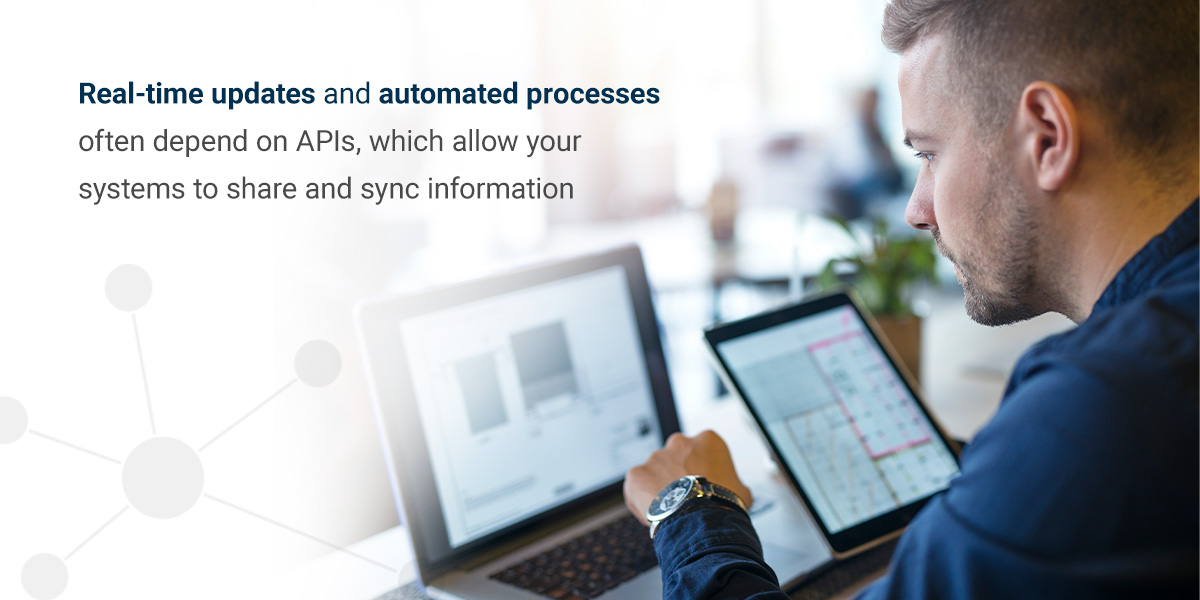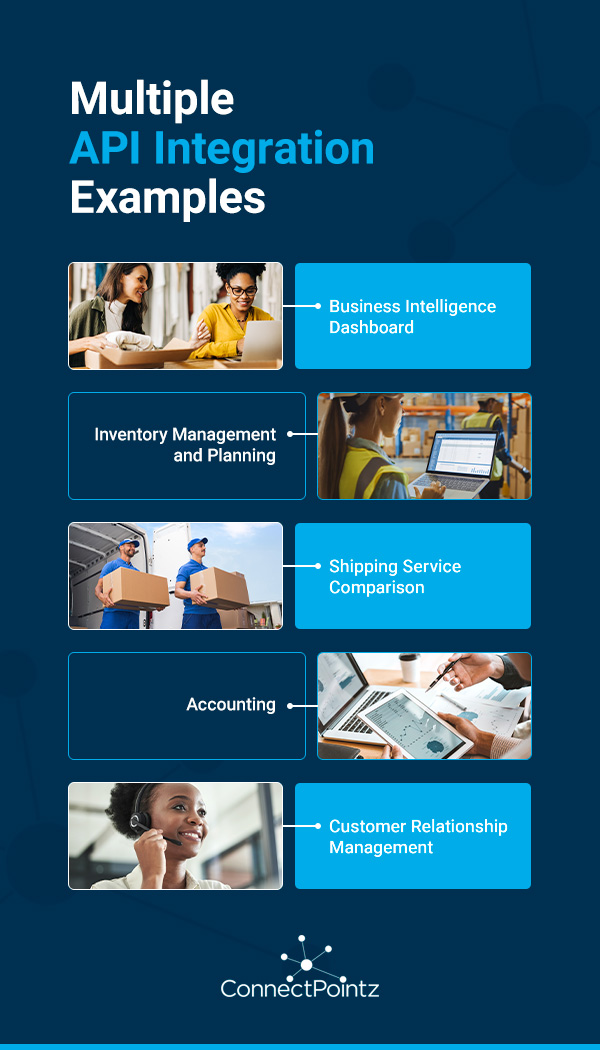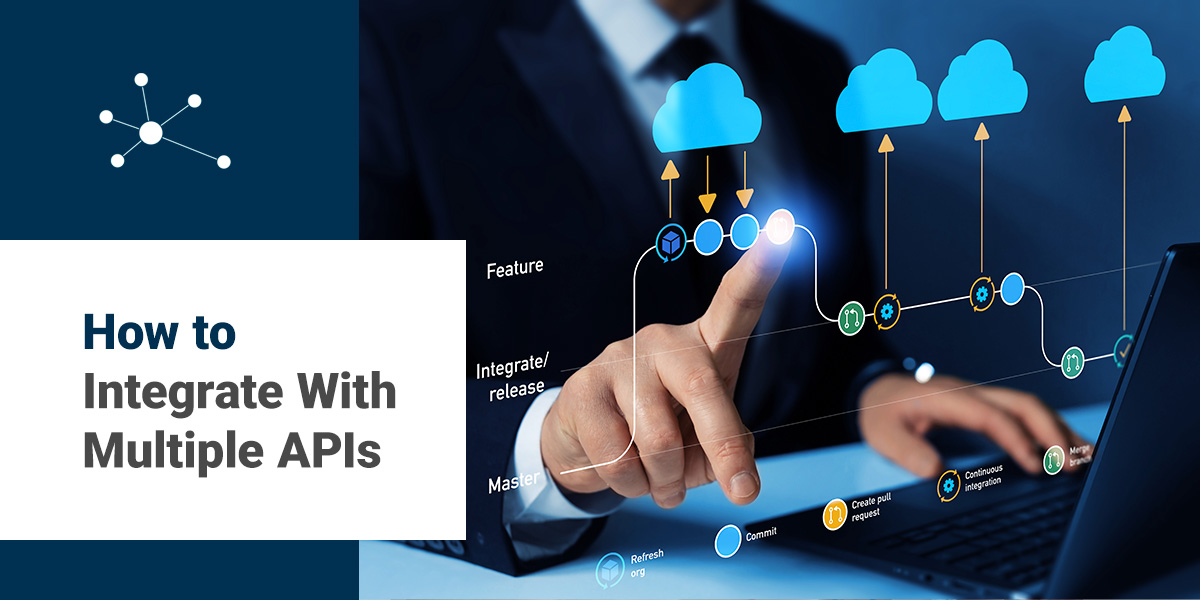Modern businesses use an average of 130 apps through software as a service (SaaS), and application programming interfaces (APIs) are crucial for making these programs work together. With the help of API connectors, organizations can connect a wide range of tools, from payment processing systems and virtual storefronts to security platforms and business management software. Ensuring seamless connectors requires intricate, well-designed API networks.
Whether you connect APIs manually or work with an API partner, linking multiple systems creates extensive opportunities, like reaching new markets or automating time-consuming processes. To help you leverage these benefits and build a connected business environment, we've compiled some guidelines on how to integrate with multiple APIs.
An Overview of API Integrations
APIs bridge the gap between two applications, allowing them to share information without having access to the underlying infrastructure of the other program. An API outlines protocols and rules that tell the apps how to communicate.
For example, if you've used PayPal to check out at an e-commerce store, you likely used an API. The API allows the buyer to log into PayPal, which then shares basic payment information directly with the e-commerce seller — all while appearing seamless to the buyer.
A PayPal integration is just one example of an API, which comes in many different styles. Its functions range from syncing a database or offering one-click login to fully automating a complex purchasing workflow. You can use APIs to:
- Implement new features: Unlock new capabilities by connecting platforms, such as online storefronts and inventory management systems.
- Use shared databases: APIs allow you to work from one set of data and centralize information for greater simplicity and accuracy.
- Automate tasks: Direct connectors can facilitate hands-off business processes. APIs are often crucial for highly automated systems.
- Connect third-party systems securely: You likely work with many partners, and APIs offer a quick, secure method of sharing and collecting information.
- Streamline business processes: Accuracy, simplicity and speed are just a few ways API integrations support more efficient workflows.
What Is Multiple API Integration?
Multiple API integrations connect two or more APIs within one system. Rather than jumping between multiple programs or manually transferring data between them, integrating from multiple APIs lets you seamlessly access information from one place. Real-time updates and automated processes often depend on APIs, which allow your systems to share and sync information. The process can be complex, but it's highly customizable, so you can craft numerous APIs and processes that build off each other.

For example, an e-commerce storefront might use APIs for payment processing, shipping and inventory management. While browsing, customers see updated product availability and shipping estimates in their carts, and they can pay for items with a secure, trusted payment system. After an order is placed, these integrated APIs can make multiple adjustments in the retailer's main system.
Once the payment processor confirms the payment went through, the shipping API might create a shipping label, while the inventory API adjusts stock counts. From this point, other APIs can take further action, such as logging order information in a customer relationship manager (CRM) or sending it to an accounting program. These actions occur automatically, limiting the risk of errors and slow manual entry.
Another way to use multiple API integrations is to enable access within one system. Instead of having employees remember countless login credentials and navigate to different programs, you can use APIs to provide access to one system's data from within another system. For instance, you might embed a shipping tool within a CRM so customer service agents can quickly view tracking information or estimate shipping costs. They can provide accurate, timely information to callers.
How to Integrate With Multiple APIs
You can typically integrate your systems with multiple APIs in one of two ways — manually or with integration platform as a service (iPaaS). iPaaS allows an integration expert to create and manage your APIs.
Whether you do it yourself or work with a partner, API integration will involve the following aspects:
- Maintenance: After integration, APIs require regular upkeep. Updates to your business software or tech infrastructure could cause problems with APIs. Updating and retesting these integrations prevents hiccups.
- Partnerships and licensure: Many software companies require formal partnerships before allowing you to use their APIs. You may need to pay attention to your relationships with these companies and buy and renew licenses. A marketplace of prebuilt APIs from an iPaaS provider can greatly simplify these setup requirements and management tasks.
- Training: Depending on the complexity of your solution, training requirements can be robust. Your staff will need to know how to use the API effectively and efficiently. If you integrate APIs manually, your IT team may also need training on working with them.
- Compliance: Trading partners can have detailed requirements for their processes and preferences. For example, a supplier might change the format they want you to use for purchase orders. If these requirements change, maintaining your good standing may call for prompt updates to APIs, particularly when used in automation.
Here are two ways to integrate with multiple APIs:
1. Manual Integration
If you were to integrate multiple APIs yourself, you would need to create each integration individually. After planning out which APIs you want to integrate, your IT team will map out the connections between each platform and test them. In an omnichannel environment, this process may involve collecting data from multiple sources and ensuring APIs don't clash with each other.
Since your in-house team will perform the steps of manual integration, you'll take on other associated tasks and their costs, such as the time commitment of building new APIs and potentially costly errors. Many IT teams do not have API specialists to mitigate these problems.
2. iPaaS Integration
iPaaS uses a cloud-based system to link your cloud and on-premise applications. It provides an intuitive interface that allows users without much technical skill to set up multiple API integrations. Your IT team is free to focus on other tasks, while the iPaaS provider's integration experts map data from one source to another. Some iPaaS providers also help with maintaining integrations, onboarding new partners and training your team members.
If your IT team has limited resources, iPaaS can be essential for unlocking the benefits of APIs. This service can help you build more complex APIs and integrate them in unique ways tailored to your operations. Since the process is much faster, you can quickly pivot to changing market demands and scale your business as needed. If you want to upgrade your software, an iPaaS solution also helps you avoid a drawn-out process of rebuilding your APIs.
Multiple API Integration Examples

With so much customization, multiple API integrations can come in many configurations. Here are a few examples of how you might use them in business scenarios:
Business Intelligence Dashboard
Many organizations build resources for business intelligence (BI), but without APIs, you might limit the data you can analyze. Integrating with multiple APIs could allow a BI dashboard to pull data from diverse sources. For example, an omnichannel retailer might build a complete picture of sales data by collecting information from the following platforms:
- A point-of-sale system or accounting software that logs in-store sales
- An online storefront
- Third-party sales channels, such as Amazon and Walmart
Connecting these disparate resources can introduce valuable insights into the entire landscape of operations. Linking other resources, like a warehouse management system (WMS) or information from shipping providers, could provide further data on product movement or capacity planning.
Inventory Management and Planning
Up-to-date information is crucial for meeting the needs of fast-paced customers. Whether using a WMS or third-party logistics provider (3PL), integrating with multiple APIs can help organizations make more informed decisions based on the latest data.
For example, a manufacturer might integrate multiple APIs for sales and distribution channels with a WMS. Inventory counts automatically adjust as distributors or retailers place orders for products. These integrations can give the manufacturer a full view of inventory changes and support accurate, updated insights for forecasting and planning efforts.
Shipping Service Comparison
Shipping costs depend on many factors, and finding the best service for a shipment can offer significant benefits, like cost savings and improved customer satisfaction. By integrating APIs from multiple shipping services, like UPS and FedEx, you can compare options and even set up systems that automatically select the best service for a given package.
Another approach might be allowing e-commerce customers to choose their preferred service at checkout. This can improve their experience and chances of finding a satisfactory shipping option.
Accounting
Accounting teams must manage financials from many diverse sources, like sales channels and operational expenses. By integrating these sources, accounting teams can:
- Automatically sync data between platforms, like importing general ledger transactions or updating prices in a WMS.
- Track accounts payable and receivable across trading partners.
- Forecast and report on financial data from other business systems.
- Automate time-consuming tasks, such as reconciliation and building invoices, with custom workflows.
- Easily calculate taxes, such as overtime wages or sales tax on different products.
Customer Relationship Management
Customer relationship management (CRM) systems can dramatically improve how businesses connect to customers. In an omnichannel environment, an integrated CRM platform is crucial for understanding a customer's touchpoints with a company and providing a cohesive experience.
When a customer calls, agents can view recent orders, outstanding balances, notes and other data pulled from APIs. Since 60% of customers say they would be more loyal to a brand with fast customer service, immediate access to information can go a long way. Other API integrations to support customer satisfaction might include automatically sending tracking numbers to the customer's email or allowing users to pay a bill online.
Why Integrate With Multiple APIs?
The potential for multiple API integrations is vast, and their benefits go far beyond convenience or “nice-to-have” features.
1. Greater Efficiency
One of the biggest advantages of integrating APIs comes from efficiency and automation. You can streamline processes and save time in several ways, such as:
- Eliminating time-consuming tasks: Teams can avoid repetitive, monotonous tasks, like copying data from one platform to another. Instead, employees can focus on more valuable work that supports larger business goals.
- Automating workflows: Complex workflows often slow down operational processes, like monthly financial documentation or sign-offs on purchase orders. By automating steps like approvals and submissions, API integrations facilitate the flow of data for smooth, timely workflows.
- Minimizing delays: Up-to-date information can also speed up processes. For instance, rather than waiting for someone to manually adjust inventory counts from yesterday's sales, you can place your next order knowing the counts are accurate.
If you use iPaaS, your team also saves significant time by avoiding the complicated process of building out and maintaining integrations.
2. Fewer Errors

Human error makes manual data entry less reliable. Attentive, well-trained employees will still make mistakes, but automated data transfers from APIs eliminate this step for more accurate, dependable information. You can make decisions with more confidence, enjoy a better reputation and avoid spending more time than necessary fixing problems.
Another way APIs can reduce errors is by using shared datasets. With disconnected systems, you may have multiple sets of information. If they don't sync up, you can have outdated or duplicated information and organizational issues. APIs allow your systems to work from the same set of data to avoid these problems.
3. Improved Customer Satisfaction
With speed and efficiency comes happier customers. Multiple API integrations allow you to meet the fast-paced demands of today's omnichannel customers, who expect a cohesive experience every time they interact with an organization — from in-store shopping and customer service interactions to browsing an app or website.
4. Competitive Advantages
When you can integrate with multiple APIs and explore new capabilities, you can appeal to more customers and markets. For instance, selling products on third-party sales channels can expand your audience much further than only selling on your website, but extra channels can get complicated. Integrations allow you to smoothly incorporate these channels into your existing systems so you can reach more customers.
The many benefits of API integration also support strategic advantages. After all, most people would prefer to do business with a fast, reliable and flexible company.
5. Better Decision-Making
Multiple API integrations bring all of your data under one roof. Whichever systems you use, APIs allow you to see the entire picture with updated information. From large-scale business decisions to transaction-specific concerns, you and your team can make decisions based on the best data available.
Get API Integration Solutions From ConnectPointz
Integrating multiple APIs is crucial for many modern business operations, connecting diverse programs and ensuring more accurate, updated information. While building these integrations can be complex, a powerful iPaaS solution allows you to reap the benefits of APIs without increasing the burden on your IT team.
ConnectPointz offers a user-friendly solution with prebuilt connectors for many business platforms ranging from e-commerce systems and sales channels to inventory, accounting, CRM and 3PL platforms. If you need a custom solution, we can help there, too.
With end-to-end automation services, affordable and predictable pricing and decades of expertise, ConnectPointz has become the trusted integrations provider for businesses of all types. You can expect personalized support from live, English-speaking agents if you need help, and our wide array of services allows us to meet ever-changing business demands.
Reach out today to get started and learn more about our robust API integration solutions.











































